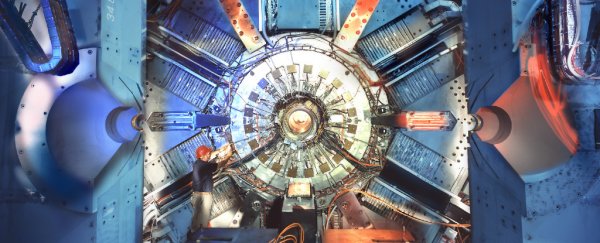Dark matter continues to be an itch particle physicists just can't scratch. Whatever is tugging at the Universe's more visible material, it just doesn't want to be found.
A fresh look at existing data has failed to detect any 'dark photons' - particles that would help describe the forces behind the shadowy masses. It doesn't rule out their existence, but it does leave few places they could be lurking.
From 1999 to 2008, physicists at Stanford University's SLAC National Accelerator Laboratory in California smashed particles of matter and antimatter together and sifted through the remains in search of hidden secrets.
To this day, researchers are digging through the data produced, looking for clues to the identity of one of science's biggest mysteries - all that dark stuff making up our universe.
Even once we add up the total mass of stars and dust and gas, we still don't have enough gravity to explain how galaxies stick together. Either our sums are seriously wrong – which is possible, but unlikely – or there has to be more stuff we can't see.
Whatever that stuff happens to be, dark matter makes up about 25 percent of the Universe's mass. It just doesn't make itself easily known, and not for want of looking.
It's possible that dark matter could be dense clumps of normal matter behaving oddly, or strange dimensions curled up in ways we can't detect.
Or it might be a different class of matter altogether. A darker class.
This family of dark particles would still behave according to textbook physics. In other words, there could feasibly be forces between different kinds of dark matter electrons or whole dark atoms.
And just as photons mediate electromagnetic forces, there could be 'dark' photons zipping back and forth between these bits of dark matter.
If they exist, dark photons would almost certainly have certain properties which would make their presence known in the data of colliding particles.
"The signature (of a dark photon) in the detector would be extremely simple: one high-energy photon, without any other activity," says Yury Kolomensky, a physicist in the Nuclear Science Division at Berkeley Lab in California.
So far, no signs of these dark photon fingerprints have appeared in the kinds of energies reached by the accelerator in what is known as the BaBar experiment.
"Although it does not rule out the existence of dark photons," says BaBar spokesperson Michael Roney, "the BaBar results do limit where they can hide, and definitively rule out their explanation for another intriguing mystery associated with the property of the subatomic particle known as the muon,"
Muons are charged elementary particles, not unlike electrons. The standard model of physics – the best theory for explaining how all particles interact – describes how muons should look.
The problem is one of the muon's fundamental properties, called spin, doesn't quite look like it should in the model. Earlier measurements at Brookhaven National Laboratory were off by 0.0002 percent from predictions.
What's causing this anomaly? Who knows. Certainly not dark photons.
"Dark photons could bridge this hidden divide between dark matter and our world, so it would be exciting if we had seen it," says Kolomensky.
This isn't exactly a death knell for the photon's shadowy twin, and more powerful experiments are already warming up to continue the search for hidden physics. But the odds of finding it just went down significantly.
Closing doors and narrowing windows might not seem as exciting as great revelations in science. But as cool as 'dark physics' seems, renewed confidence on where to focus our hunt for answers is far more productive.
This research was published in Physical Review Letters.
